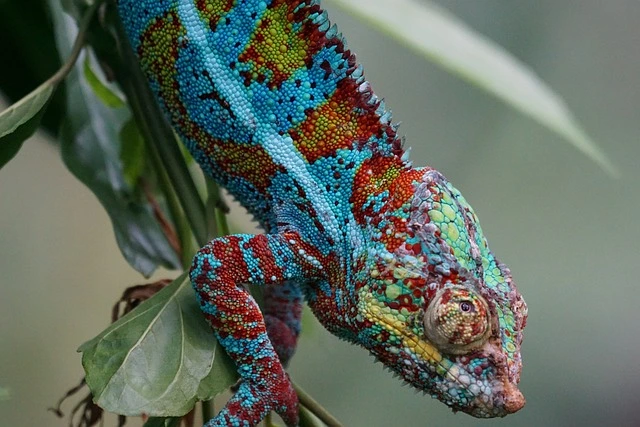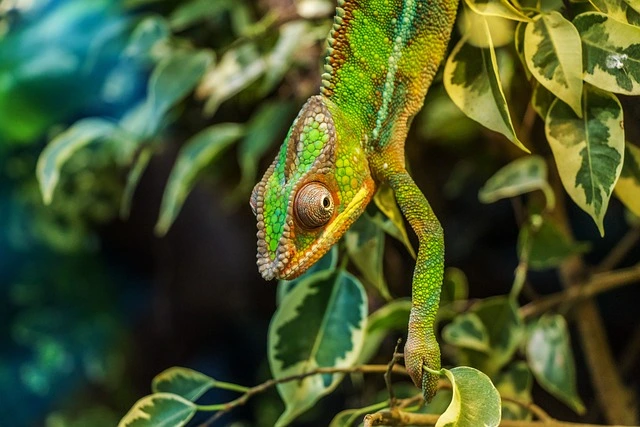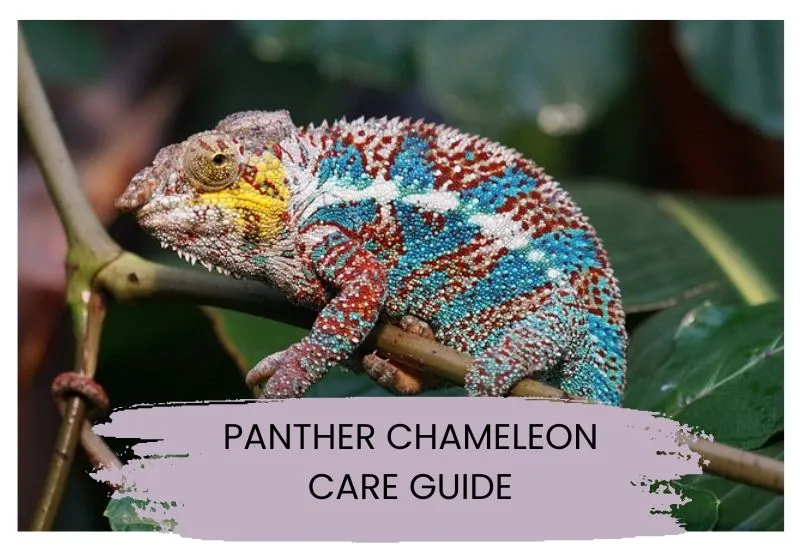If you’re a reptile enthusiast, you’ll know that Panther Chameleons are some of the most stunning and fascinating reptiles you can keep as a pet. Not only are they visually striking with their vibrant colours and unique markings, but they also have an incredible ability to change their skin colour, pattern and texture. But with great beauty comes great responsibility – and it’s vital to provide these amazing creatures with the right care to ensure their health and happiness.
In this blog post, we’ll cover everything you need to know about caring for panther chameleons, including habitat and enclosure requirements, feeding and nutrition, health and wellness, handling and socialization, and more. Whether you’re an experienced reptile owner or new to the hobby, this guide will give you all the information you need to provide the best possible care for your panther chameleon. Let’s get started!
| Characteristic | Description |
|---|---|
| Size | 35-50 cm in length |
| Lifespan | Up to 7–8 years in captivity |
| Colour | Variable based on species and sex; males are brightly coloured with blue, green, and red while females are typically shades of brown and green |
| Diet | Live insects such as crickets, roaches, locusts, and silkworms |
| Original Habitat | Madagascar rainforests |
| Enclosure Size | At least 60×60×120cm for adults |
| Experience Level | Beginner to Intermediate |
Keeping Panther chameleon as a pet
Owning a Panther Chameleon can be a unique and rewarding experience for those willing to put in the time and effort to properly care for these fascinating creatures. With their bright colours and unique ability to change colour, Panther Chameleons are a fascinating addition to any reptile collection. However, as with any exotic pet, owning a Panther Chameleon requires special knowledge and care to ensure their health and happiness. In this article, we’ll explore what it’s like to own a Panther Chameleon, including their care requirements, behaviour and what to expect as a chameleon owner.

Ideal enclosure size
Panther Chameleons require spacious enclosures to ensure they have enough room to move and climb. The ideal enclosure size for an adult panther chameleon is at least 60 centimetres (0.6 metres) long, 60 centimetres (0.6 metres) wide and 1.2 metres high. Younger chameleons can be kept in smaller enclosures, but it is important to increase the enclosure size as they grow. In addition, providing vertical space with high enclosures is essential, as panther chameleons are arboreal and require climbing space.
Lighting and heating requirements
Panther chameleons have specific lighting and heating requirements to maintain their health. The enclosure should have both UVB and UVA lighting. The UVB lighting should be placed within 30 cm of the basking area, and the UVA lighting should be evenly distributed throughout the enclosure. For heating, a basking area should be provided with a heat lamp or ceramic heater. The temperature gradient should be between 25 °C and 30 °C during the day and no lower than 18 °C at night.
Substrate and decoration
It is recommended to use a substrate that retains moisture, such as coco fibre or peat moss. This will help to maintain the correct humidity level in the enclosure.
In terms of decoration, Panther Chameleons need plenty of climbing branches and foliage to mimic their natural environment. Providing live plants such as ficus or pothos can also help maintain humidity levels and provide hiding places.
Cleaning and maintenance
It is important to clean the enclosure regularly to prevent the build-up of bacteria and other harmful substances. Spot cleaning should be done daily and a full cleaning every few weeks. All substrates, decor, and surfaces should be cleaned and disinfected with a reptile safe disinfectant. It is also critical to maintain proper humidity levels by misting the enclosure at least twice a day.
Diet and nutritional requirements
Panther chameleons require a varied diet to maintain proper nutrition. Their diet should consist mainly of live insects. It is also important to provide a variety of insects to ensure a balanced diet. Insects can be gutted with fresh vegetables or fruit before feeding to increase their nutritional value. It is also recommended to dust the insects with a calcium and vitamin D3 supplement before feeding to ensure proper nutrition.

Some suitable feeder insects include:
- Crickets
- Dubia Roaches
- Locusts
- Mealworms (in moderation)
- Silk Worms
- Superworms (in moderation)
Feeding schedule
Panther chameleons should be fed daily or every other day, depending on their age and size. Younger chameleons require more frequent feeding, while adult chameleons can be fed every other day. It is important to monitor their weight and adjust their feeding schedule accordingly. Overfeeding can lead to obesity and other health problems.
Proper supplementation
In addition to a varied diet, Panther Chameleons require proper supplementation to maintain their health. Calcium and vitamin D3 supplements should be given before feeding and at least twice a week. However, over supplementation can be harmful, so it is essential to follow the recommended dosage guidelines. It is also advisable to give them a multivitamin supplement once a month to ensure they are getting all the vitamins and minerals they need.
Handling your Panther Chameleon
Panther chameleons are not typically a handling friendly species, but with proper handling techniques they can become more tolerant of human interaction. It’s important to approach your chameleon slowly and calmly, using a flat hand to support its body. Avoid grabbing or squeezing them as this can cause stress and injury. Start with short handling sessions and gradually increase the length of time as they become more comfortable.
Bonding with your chameleon
Although panther chameleons may never become completely comfortable with handling, there are ways to bond with your chameleon. Spending time near their enclosure, talking to them in a calm voice, and offering them treats by hand will help them associate you with positive experiences. It’s also critical to respect their space and body language, and never force them to interact if they’re not comfortable.
Socialisation with other animals
Panther chameleons are solitary creatures and do not require socialisation with other chameleons or humans. In fact, too much interaction can cause stress and be detrimental to their health. It’s important to provide a comfortable and spacious enclosure with plenty of hiding and climbing opportunities. Providing enrichment activities such as live plants and misting can also help to keep them stimulated and happy.
Overall, it’s important to respect your chameleon’s boundaries and natural tendencies when it comes to handling and socialisation. By providing a comfortable and enriched environment, you can ensure that they have the best possible quality of life.
Panther Chameleon health concerns
While Panther Chameleons are generally hardy animals, there are a few health concerns that owners should be aware of:
- Metabolic Bone Disease (MBD): MBD is a common condition in captive reptiles, including Panther Chameleons, that results from a lack of calcium in their diet. Symptoms include difficulty climbing, bowed legs, and swelling in the jaw.
- Respiratory Infections: Respiratory infections can occur when Panther Chameleons are kept in damp or dirty conditions. Symptoms include lethargy, loss of appetite, and discharge from the nose or mouth.
- Dehydration: Panther Chameleons require high humidity levels in their enclosure, but it’s important to balance this with proper ventilation to prevent mold growth. Dehydration can occur if the enclosure is too dry, which can lead to lethargy and loss of appetite.
- Parasites: Panther Chameleons can be susceptible to internal and external parasites, such as mites and worms. Regular fecal exams and preventative treatments can help keep parasites at bay.

How to tell if your Panther Chameleon is healthy?
Here are some signs to look for to determine if your Panther Chameleon is healthy:
- Active and Alert: A healthy Panther Chameleon is typically active and alert during the day, moving around its enclosure and responding to its surroundings.
- Bright and Vibrant Colours: The colours of a healthy Panther Chameleon should be bright and vibrant, with no signs of dullness or discolouration.
- Clear Eyes: A healthy Panther Chameleon should have clear, bright eyes with no signs of discharge or swelling.
- Eating and drinking regularly: A healthy Panther Chameleon should have a healthy appetite and eat and drink regularly. Any significant changes in appetite or behaviour should be noted.
- Normal elimination: Regular bowel movements are a sign of a healthy digestive system. Any changes in the frequency or appearance of their stools should be noted.
- Good body condition: A healthy Panther Chameleon should be in good condition, with no signs of emaciation or bloating.
It’s important to note that some changes in behaviour or appearance can be subtle, so it’s a good idea to observe your chameleon regularly and monitor any changes. If you notice any worrying symptoms, seek veterinary advice immediately.
What we have learned
Panther Chameleons are fascinating and beautiful creatures that require proper care and attention to thrive as pets. From their habitat and enclosure to their diet and handling, there are many important factors to consider when owning a Panther Chameleon.
Some of the key points to consider include providing a spacious and properly equipped enclosure with the correct lighting, heating, substrate and decoration. A varied diet of live insects and proper supplementation is also essential for their health.
When it comes to handling and socialisation, it’s important to respect your chameleon’s boundaries and natural tendencies. With patience and proper handling techniques, you can bond with your chameleon and provide it with a comfortable and enriching environment.
As a Panther Chameleon owner, it’s important to stay informed and connected with other reptile enthusiasts. Share your experience with this fascinating chameleon
